All Exams >
UCAT >
Abstract Reasoning for UCAT >
All Questions
All questions of Position Patterns for UCAT Exam
Directions: You will be presented with two sets of shapes labelled “Set A” and “Set B”. You will be given a test shape and asked to decide whether the test shape belongs to Set A, Set B, or Neither.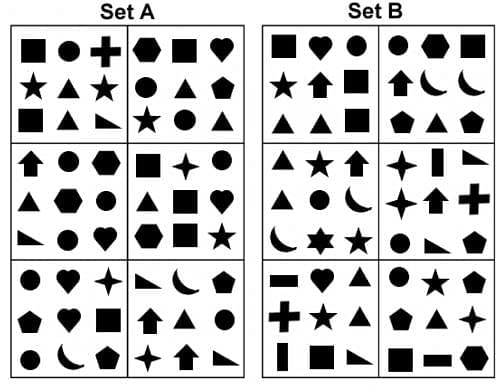 Q.
Q. 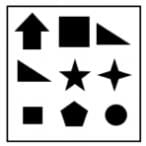
- a)Set A
- b)Set B
- c)Neither
Correct answer is option 'C'. Can you explain this answer?
Directions: You will be presented with two sets of shapes labelled “Set A” and “Set B”. You will be given a test shape and asked to decide whether the test shape belongs to Set A, Set B, or Neither.

Q. 

a)
Set A
b)
Set B
c)
Neither

|
Elite Coaching Classes answered |
C – The shape with the most sides is the ten-sided star in the central position.
Pattern: In Set A, the element with the most sides is situated in a corner; in Set B, the element with the most sides is situated on an edge.
Method: It should go without saying that Orientation, Colour and Size, and also simple Number, are unlikely to be relevant to the pattern. This leaves Position and Shape/Number. As it happens, the pattern concerns the position of shapes with a particular number of sides. The best way to spot this pattern is by focussing on the unusual shapes first – for instance, the cross only appears once, in a corner, in Set A, but twice, along an edge, in Set B. That said, the Sets are littered with red-herrings. Learning the hierarchy of these shapes by number of sides will help you spot similar patterns in the future.
Directions: You will be presented with two sets of shapes labelled “Set A” and “Set B”. You will be given a test shape and asked to decide whether the test shape belongs to Set A, Set B, or Neither.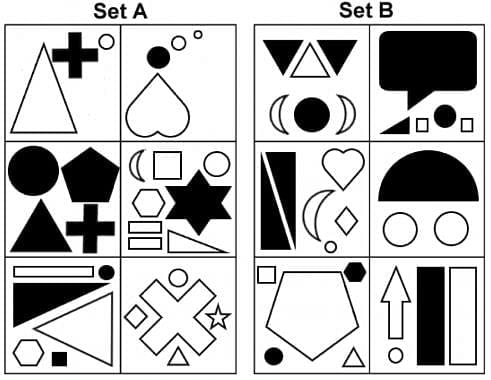 Q.
Q. 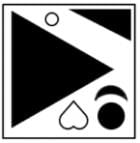
- a)Set A
- b)Set B
- c)Neither
Correct answer is option 'C'. Can you explain this answer?
Directions: You will be presented with two sets of shapes labelled “Set A” and “Set B”. You will be given a test shape and asked to decide whether the test shape belongs to Set A, Set B, or Neither.

Q. 

a)
Set A
b)
Set B
c)
Neither
|
|
Swati Sharma answered |
C – This features a circle in the top half and a circle in the bottom half.
Pattern: Members of Set A feature at least one circle in the top half of the box; members of Set B feature at least one circle in the bottom half of the box.
Method: Size ought to be your first thought. However, there is no consistent rule relating the largest shapes across each set to Shape, Position, Orientation or Colour. Thus, isolate the top two members of Set A and the middle-right of Set B for comparison. The mixture of black and white shapes is striking, but more so is the preponderance of circles. You can work out the pattern from these simpler cases and test it across the other members of each set.
Directions: You will be presented with two sets of shapes labelled “Set A” and “Set B”. You will be given a test shape and asked to decide whether the test shape belongs to Set A, Set B, or Neither.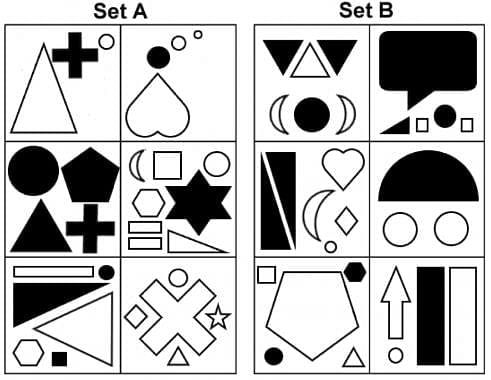 Q.
Q. 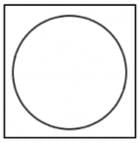
- a)Set A
- b)Set B
- c)Neither
Correct answer is option 'C'. Can you explain this answer?
Directions: You will be presented with two sets of shapes labelled “Set A” and “Set B”. You will be given a test shape and asked to decide whether the test shape belongs to Set A, Set B, or Neither.

Q. 

a)
Set A
b)
Set B
c)
Neither

|
Elite Coaching Classes answered |
C – This circle is equally distributed between the top and bottom halves.
Pattern: Members of Set A feature at least one circle in the top half of the box; members of Set B feature at least one circle in the bottom half of the box.
Method: Size ought to be your first thought. However, there is no consistent rule relating the largest shapes across each set to Shape, Position, Orientation or Colour. Thus, isolate the top two members of Set A and the middle-right of Set B for comparison. The mixture of black and white shapes is striking, but more so is the preponderance of circles. You can work out the pattern from these simpler cases and test it across the other members of each set.
Directions: You will be presented with two sets of shapes labelled “Set A” and “Set B”. You will be given a test shape and asked to decide whether the test shape belongs to Set A, Set B, or Neither.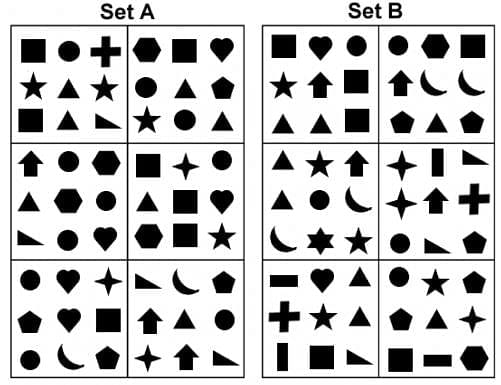 Q.
Q. 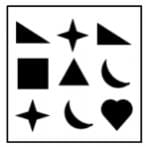
- a)Set A
- b)Set B
- c)Neither
Correct answer is option 'C'. Can you explain this answer?
Directions: You will be presented with two sets of shapes labelled “Set A” and “Set B”. You will be given a test shape and asked to decide whether the test shape belongs to Set A, Set B, or Neither.

Q. 

a)
Set A
b)
Set B
c)
Neither
|
|
Swati Sharma answered |
C – The most-sided shape is the octagonal star – but there are copies of it both in a corner and along an edge.
Pattern: In Set A, the element with the most sides is situated in a corner; in Set B, the element with the most sides is situated on an edge.
Method: It should go without saying that Orientation, Colour and Size, and also simple Number, are unlikely to be relevant to the pattern. This leaves Position and Shape/Number. As it happens, the pattern concerns the position of shapes with a particular number of sides. The best way to spot this pattern is by focussing on the unusual shapes first – for instance, the cross only appears once, in a corner, in Set A, but twice, along an edge, in Set B. That said, the Sets are littered with red-herrings. Learning the hierarchy of these shapes by number of sides will help you spot similar patterns in the future.
Directions: You will be presented with two sets of shapes labelled “Set A” and “Set B”. You will be given a test shape and asked to decide whether the test shape belongs to Set A, Set B, or Neither.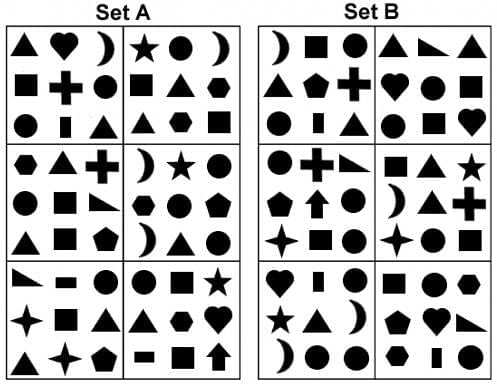 Q.
Q. 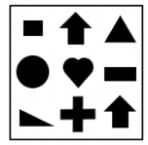
- a)Set A
- b)Set B
- c)Neither
Correct answer is option 'A'. Can you explain this answer?
Directions: You will be presented with two sets of shapes labelled “Set A” and “Set B”. You will be given a test shape and asked to decide whether the test shape belongs to Set A, Set B, or Neither.

Q. 

a)
Set A
b)
Set B
c)
Neither
|
|
Swati Sharma answered |
Set A – The triangle in the bottom-left has a circle immediately above it.
Pattern: Members of Set A feature a triangle (either right-angled or isosceles) immediately below a circle. Members of Set B feature a triangle (either right-angled or isosceles) immediately above a circle.
Method: Treat this pattern in a similar manner to the previous pattern, eliminating categories and then trying unusual shapes first. Crosses and ten- or eight-pointed stars appear randomly throughout both sets, whether centrally, along edges or in corners. Equally, arrows, hexagons, pentagons, hearts and crescents do not appear consistently enough to form a pattern. Nevertheless, each box happens to contain at least one triangle and one circle, which should help you towards the answer – the top-left member of each set can be used for helpful comparison, as highlighted in red.
Directions: You will be presented with two sets of shapes labelled “Set A” and “Set B”. You will be given a test shape and asked to decide whether the test shape belongs to Set A, Set B, or Neither.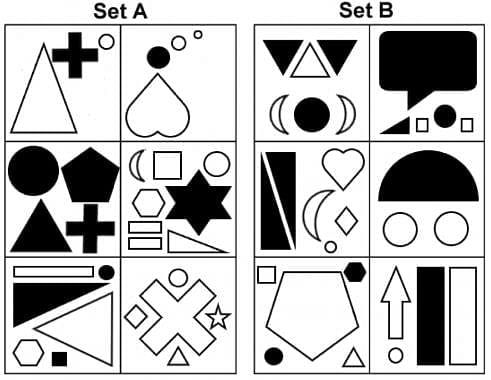 Q.
Q. 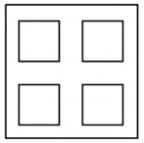
- a)Set A
- b)Set B
- c)Neither
Correct answer is option 'C'. Can you explain this answer?
Directions: You will be presented with two sets of shapes labelled “Set A” and “Set B”. You will be given a test shape and asked to decide whether the test shape belongs to Set A, Set B, or Neither.

Q. 

a)
Set A
b)
Set B
c)
Neither

|
Elite Coaching Classes answered |
C – This contains no circles.
Pattern: Members of Set A feature at least one circle in the top half of the box; members of Set B feature at least one circle in the bottom half of the box.
Method: Size ought to be your first thought. However, there is no consistent rule relating the largest shapes across each set to Shape, Position, Orientation or Colour. Thus, isolate the top two members of Set A and the middle-right of Set B for comparison. The mixture of black and white shapes is striking, but more so is the preponderance of circles. You can work out the pattern from these simpler cases and test it across the other members of each set.
Directions: You will be presented with two sets of shapes labelled “Set A” and “Set B”. You will be given a test shape and asked to decide whether the test shape belongs to Set A, Set B, or Neither.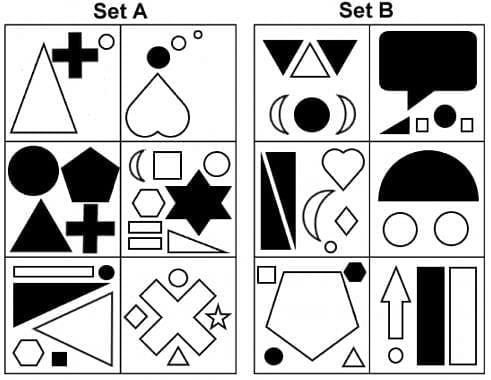 Q.
Q. 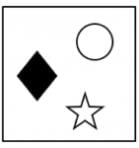
- a)Set A
- b)Set B
- c)Neither
Correct answer is option 'A'. Can you explain this answer?
Directions: You will be presented with two sets of shapes labelled “Set A” and “Set B”. You will be given a test shape and asked to decide whether the test shape belongs to Set A, Set B, or Neither.

Q. 

a)
Set A
b)
Set B
c)
Neither

|
Elite Coaching Classes answered |
Set A – This contains one circle, which is in the top half of the box.
Pattern: Members of Set A feature at least one circle in the top half of the box; members of Set B feature at least one circle in the bottom half of the box.
Method: Size ought to be your first thought. However, there is no consistent rule relating the largest shapes across each set to Shape, Position, Orientation or Colour. Thus, isolate the top two members of Set A and the middle-right of Set B for comparison. The mixture of black and white shapes is striking, but more so is the preponderance of circles. You can work out the pattern from these simpler cases and test it across the other members of each set.
Directions: You will be presented with two sets of shapes labelled “Set A” and “Set B”. You will be given a test shape and asked to decide whether the test shape belongs to Set A, Set B, or Neither.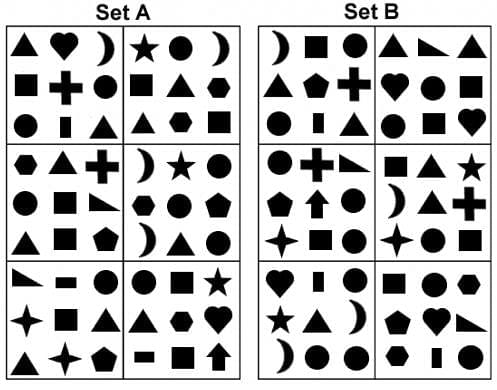 Q.
Q. 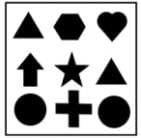
- a)Set A
- b)Set B
- c)Neither
Correct answer is option 'B'. Can you explain this answer?
Directions: You will be presented with two sets of shapes labelled “Set A” and “Set B”. You will be given a test shape and asked to decide whether the test shape belongs to Set A, Set B, or Neither.

Q. 

a)
Set A
b)
Set B
c)
Neither

|
Elite Coaching Classes answered |
Set B – The circle in the bottom-right has a triangle immediately above it.
Pattern: Members of Set A feature a triangle (either right-angled or isosceles) immediately below a circle. Members of Set B feature a triangle (either right-angled or isosceles) immediately above a circle.
Method: Treat this pattern in a similar manner to the previous pattern, eliminating categories and then trying unusual shapes first. Crosses and ten- or eight-pointed stars appear randomly throughout both sets, whether centrally, along edges or in corners. Equally, arrows, hexagons, pentagons, hearts and crescents do not appear consistently enough to form a pattern. Nevertheless, each box happens to contain at least one triangle and one circle, which should help you towards the answer – the top-left member of each set can be used for helpful comparison, as highlighted in red.
Directions: You will be presented with two sets of shapes labelled “Set A” and “Set B”. You will be given a test shape and asked to decide whether the test shape belongs to Set A, Set B, or Neither.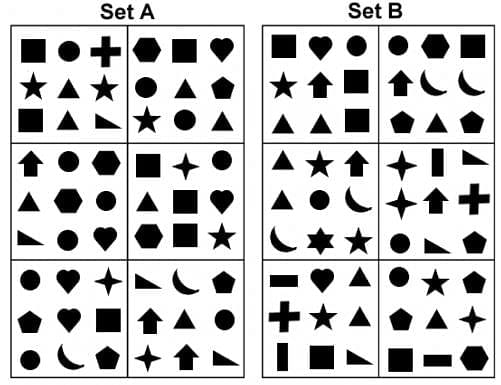 Q.
Q. 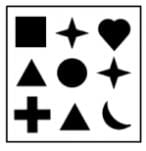
- a)Set A
- b)Set B
- c)Neither
Correct answer is option 'A'. Can you explain this answer?
Directions: You will be presented with two sets of shapes labelled “Set A” and “Set B”. You will be given a test shape and asked to decide whether the test shape belongs to Set A, Set B, or Neither.

Q. 

a)
Set A
b)
Set B
c)
Neither
|
|
Swati Sharma answered |
Set A – The cross in the bottom-left has the most sides.
Pattern: In Set A, the element with the most sides is situated in a corner; in Set B, the element with the most sides is situated on an edge.
Method: It should go without saying that Orientation, Colour and Size, and also simple Number, are unlikely to be relevant to the pattern. This leaves Position and Shape/Number. As it happens, the pattern concerns the position of shapes with a particular number of sides. The best way to spot this pattern is by focussing on the unusual shapes first – for instance, the cross only appears once, in a corner, in Set A, but twice, along an edge, in Set B. That said, the Sets are littered with red-herrings. Learning the hierarchy of these shapes by number of sides will help you spot similar patterns in the future.
Directions: You will be presented with two sets of shapes labelled “Set A” and “Set B”. You will be given a test shape and asked to decide whether the test shape belongs to Set A, Set B, or Neither.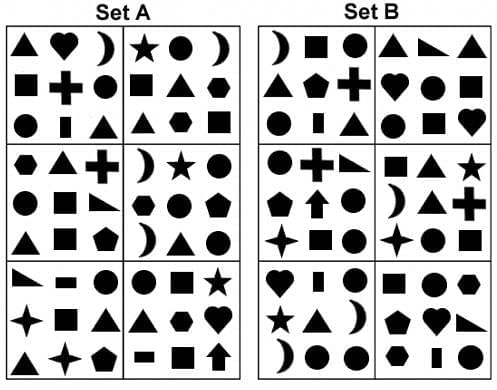 Q.
Q. 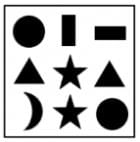
- a)Set A
- b)Set B
- c)Neither
Correct answer is option 'C'. Can you explain this answer?
Directions: You will be presented with two sets of shapes labelled “Set A” and “Set B”. You will be given a test shape and asked to decide whether the test shape belongs to Set A, Set B, or Neither.

Q. 

a)
Set A
b)
Set B
c)
Neither

|
Elite Coaching Classes answered |
C – This box features a triangle with a circle immediately above it, but also the opposite.
Pattern: Members of Set A feature a triangle (either right-angled or isosceles) immediately below a circle. Members of Set B feature a triangle (either right-angled or isosceles) immediately above a circle.
Method: Treat this pattern in a similar manner to the previous pattern, eliminating categories and then trying unusual shapes first. Crosses and ten- or eight-pointed stars appear randomly throughout both sets, whether centrally, along edges or in corners. Equally, arrows, hexagons, pentagons, hearts and crescents do not appear consistently enough to form a pattern. Nevertheless, each box happens to contain at least one triangle and one circle, which should help you towards the answer – the top-left member of each set can be used for helpful comparison, as highlighted in red.
Directions: You will be presented with two sets of shapes labelled “Set A” and “Set B”. You will be given a test shape and asked to decide whether the test shape belongs to Set A, Set B, or Neither.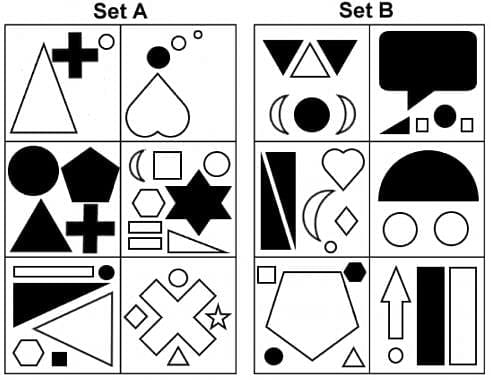 Q.
Q. 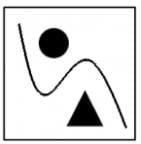
- a)Set A
- b)Set B
- c)Neither
Correct answer is option 'A'. Can you explain this answer?
Directions: You will be presented with two sets of shapes labelled “Set A” and “Set B”. You will be given a test shape and asked to decide whether the test shape belongs to Set A, Set B, or Neither.

Q. 

a)
Set A
b)
Set B
c)
Neither

|
Elite Coaching Classes answered |
Set A – This contains one circle, which is in the top half of the box.
Pattern: Members of Set A feature at least one circle in the top half of the box; members of Set B feature at least one circle in the bottom half of the box.
Method: Size ought to be your first thought. However, there is no consistent rule relating the largest shapes across each set to Shape, Position, Orientation or Colour. Thus, isolate the top two members of Set A and the middle-right of Set B for comparison. The mixture of black and white shapes is striking, but more so is the preponderance of circles. You can work out the pattern from these simpler cases and test it across the other members of each set.
Directions: You will be presented with two sets of shapes labelled “Set A” and “Set B”. You will be given a test shape and asked to decide whether the test shape belongs to Set A, Set B, or Neither.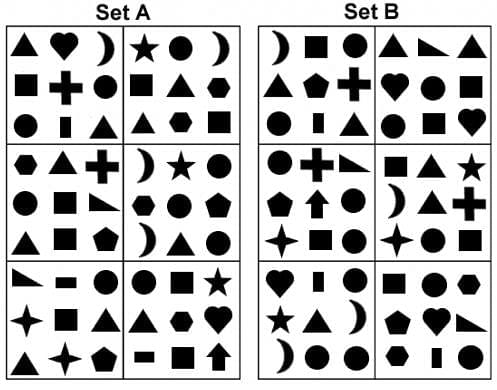 Q.
Q. 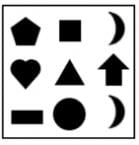
- a)Set A
- b)Set B
- c)Neither
Correct answer is option 'B'. Can you explain this answer?
Directions: You will be presented with two sets of shapes labelled “Set A” and “Set B”. You will be given a test shape and asked to decide whether the test shape belongs to Set A, Set B, or Neither.

Q. 

a)
Set A
b)
Set B
c)
Neither

|
Elite Coaching Classes answered |
Set B – The central triangle has a circle directly below it.
Pattern: Members of Set A feature a triangle (either right-angled or isosceles) immediately below a circle. Members of Set B feature a triangle (either right-angled or isosceles) immediately above a circle.
Method: Treat this pattern in a similar manner to the previous pattern, eliminating categories and then trying unusual shapes first. Crosses and ten- or eight-pointed stars appear randomly throughout both sets, whether centrally, along edges or in corners. Equally, arrows, hexagons, pentagons, hearts and crescents do not appear consistently enough to form a pattern. Nevertheless, each box happens to contain at least one triangle and one circle, which should help you towards the answer – the top-left member of each set can be used for helpful comparison, as highlighted in red.
Directions: You will be presented with two sets of shapes labelled “Set A” and “Set B”. You will be given a test shape and asked to decide whether the test shape belongs to Set A, Set B, or Neither.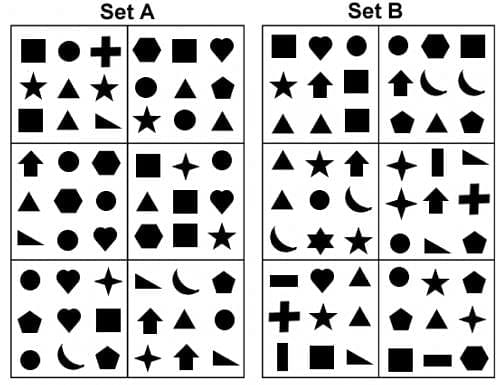 Q.
Q. 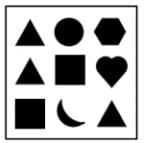
- a)Set A
- b)Set B
- c)Neither
Correct answer is option 'A'. Can you explain this answer?
Directions: You will be presented with two sets of shapes labelled “Set A” and “Set B”. You will be given a test shape and asked to decide whether the test shape belongs to Set A, Set B, or Neither.

Q. 

a)
Set A
b)
Set B
c)
Neither
|
|
Swati Sharma answered |
Set A – The hexagon in the top-right has the most sides.
Pattern: In Set A, the element with the most sides is situated in a corner; in Set B, the element with the most sides is situated on an edge.
Method: It should go without saying that Orientation, Colour and Size, and also simple Number, are unlikely to be relevant to the pattern. This leaves Position and Shape/Number. As it happens, the pattern concerns the position of shapes with a particular number of sides. The best way to spot this pattern is by focussing on the unusual shapes first – for instance, the cross only appears once, in a corner, in Set A, but twice, along an edge, in Set B. That said, the Sets are littered with red-herrings. Learning the hierarchy of these shapes by number of sides will help you spot similar patterns in the future.
Directions: You will be presented with two sets of shapes labelled “Set A” and “Set B”. You will be given a test shape and asked to decide whether the test shape belongs to Set A, Set B, or Neither.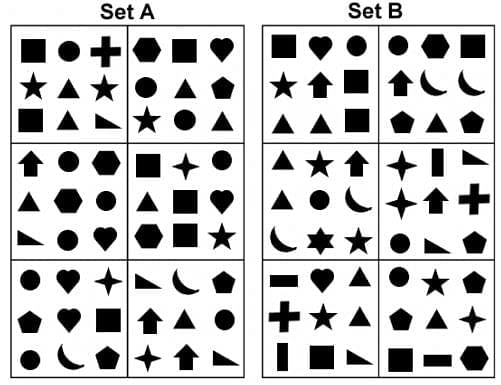 Q.
Q. 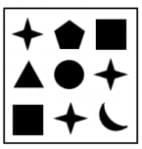
- a)Set A
- b)Set B
- c)Neither
Correct answer is option 'C'. Can you explain this answer?
Directions: You will be presented with two sets of shapes labelled “Set A” and “Set B”. You will be given a test shape and asked to decide whether the test shape belongs to Set A, Set B, or Neither.

Q. 

a)
Set A
b)
Set B
c)
Neither
|
|
Swati Sharma answered |
C – The most-sided shape is the octagonal star – but there are copies of it both in a corner and along edges.
Pattern: In Set A, the element with the most sides is situated in a corner; in Set B, the element with the most sides is situated on an edge.
Method: It should go without saying that Orientation, Colour and Size, and also simple Number, are unlikely to be relevant to the pattern. This leaves Position and Shape/Number. As it happens, the pattern concerns the position of shapes with a particular number of sides. The best way to spot this pattern is by focussing on the unusual shapes first – for instance, the cross only appears once, in a corner, in Set A, but twice, along an edge, in Set B. That said, the Sets are littered with red-herrings. Learning the hierarchy of these shapes by number of sides will help you spot similar patterns in the future.
Directions: You will be presented with two sets of shapes labelled “Set A” and “Set B”. You will be given a test shape and asked to decide whether the test shape belongs to Set A, Set B, or Neither.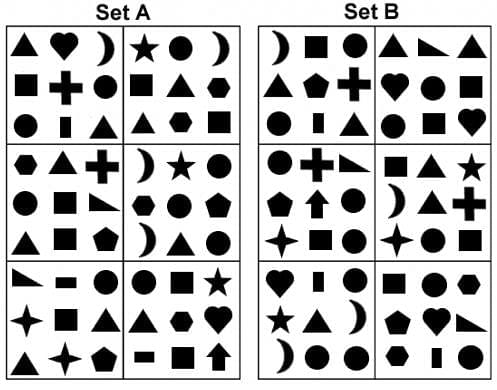 Q.
Q. 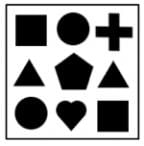
- a)Set A
- b)Set B
- c)Neither
Correct answer is option 'B'. Can you explain this answer?
Directions: You will be presented with two sets of shapes labelled “Set A” and “Set B”. You will be given a test shape and asked to decide whether the test shape belongs to Set A, Set B, or Neither.

Q. 

a)
Set A
b)
Set B
c)
Neither
|
|
Swati Sharma answered |
Set B – The circle in the bottom-left has a triangle immediately above it.
Pattern: Members of Set A feature a triangle (either right-angled or isosceles) immediately below a circle. Members of Set B feature a triangle (either right-angled or isosceles) immediately above a circle.
Method: Treat this pattern in a similar manner to the previous pattern, eliminating categories and then trying unusual shapes first. Crosses and ten- or eight-pointed stars appear randomly throughout both sets, whether centrally, along edges or in corners. Equally, arrows, hexagons, pentagons, hearts and crescents do not appear consistently enough to form a pattern. Nevertheless, each box happens to contain at least one triangle and one circle, which should help you towards the answer – the top-left member of each set can be used for helpful comparison, as highlighted in red.
Chapter doubts & questions for Position Patterns - Abstract Reasoning for UCAT 2025 is part of UCAT exam preparation. The chapters have been prepared according to the UCAT exam syllabus. The Chapter doubts & questions, notes, tests & MCQs are made for UCAT 2025 Exam. Find important definitions, questions, notes, meanings, examples, exercises, MCQs and online tests here.
Chapter doubts & questions of Position Patterns - Abstract Reasoning for UCAT in English & Hindi are available as part of UCAT exam.
Download more important topics, notes, lectures and mock test series for UCAT Exam by signing up for free.
Abstract Reasoning for UCAT
5 videos|3 docs|4 tests
|
Signup to see your scores go up within 7 days!
Study with 1000+ FREE Docs, Videos & Tests
10M+ students study on EduRev

Contact Support
Our team is online on weekdays between 10 AM - 7 PM
Typical reply within 3 hours
|
Free Exam Preparation
at your Fingertips!
Access Free Study Material - Test Series, Structured Courses, Free Videos & Study Notes and Prepare for Your Exam With Ease

 Join the 10M+ students on EduRev
Join the 10M+ students on EduRev
|

|
Forgot Password
OR
Signup to see your scores
go up within 7 days!
Access 1000+ FREE Docs, Videos and Tests
Takes less than 10 seconds to signup










